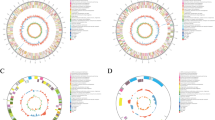Abstract
Bacterial aggregation has important implications for the maintenance of bacteria in engineered environments. The triggers for aggregation, however, are poorly understood. A strain of Acidovorax temperans CB2Hn isolated from activated sludge was found to exhibit transient aggregation and was applied as a model to investigate factors that regulate biological aggregation. Growth kinetic studies indicate CB2Hn has exponential growth rates (μ max) ranging from 0.11 to 0.75 (log(CFU mL−1)h−1) depending on nutrient conditions. CB2Hn exhibited variable aggregation in growth media that differed in the type of available carbon. Aggregation indices and extracellular polysaccharide polymer levels showed transient maxima which occurred at different points in the growth curve for each medium type. Maximum aggregation points were detected at the beginning of log phase in media containing complex carbon sources. In contrast, maximum values were detected in early log phase and mid-to-late log phase in media containing both simple and complex carbon sources. The results suggest that aggregation is regulated by nutritional cues and is possibly triggered by the switch to utilisation of complex carbon substrates.


Similar content being viewed by others
References
Bonet R, Simon-Pujol MD, Congregado F (1993) Effects of nutrients on exopolysaccharide production and surface properties on Aeromonas salmonicida. Appl Environ Microbiol 59:2437–2441
Bossier P, Verstraete W (1996) Comamonas testeroni colony phenotype influences exopolysaccharide production and coaggregation with yeast cells. Appl Environ Microbiol 62:2687–2691
Bramhachari PV, Dubey SK (2006) Isolation and characterisation of exopolysaccharide produced by Vibrio harveyi strain VB23. Lett Appl Microbiol 43:571–577
Burdman S, Jurkevitch E, Schwartsburd B, Hampel M, Okon Y (1998) Aggregation in Azospirillum brasilense: effects of chemical and physical factors and involvement of extracellular components. Microbiology 144:1989–1999
Burdman S, Jurkevitch E, Sori-Diaz ME, Gil Serrano AM, Okon Y (2000) Extracellular polysaccharide composition of Azospirillum brasilense and its regulation with cell aggregation. FEMS Microbiol Lett 189:259–264
Chowdhury BR, Chakraborty R, Chaudhuri UR (2007) Validity of modified Gompertz and logistic models in predicting cell growth of Pediococcus acidilactici H during the production of bacteriocin pediocin AcH. J Food Eng 80:1171–1175
Edens NK, Reaves LA, Bergana MS, Reyzer IL, O’Mara P, Baxter JH, Snowden MK (2002) Yeast extract stimulates glucose metabolism and inhibits lipolysis in rat adipocytes in vitro. J Nutr 132:1141–1148
Ehlers GAC, Turner SJ (2011) Evaluation of extracellular biopolymer and its impact on bioflocculation in activated sludge bioreactors. Water Sci Technol 63(4):689–694
Ehlers GAC, Wagachchi D, Turner SJ (2012) Nutrient conditions and reactor configurations influence floc size distribution and settling properties. Water Sci Technol 65(1):156–163
Gibson AM, Bratchell N, Roberts TA (1987) The effect of sodium chloride and temperature on the rate and extent of growth of Clostridium botulinum type A in pasteurized pork slurry. J Appl Bacteriol 62:479–490
Heylen K, Lebbe L, De Vos P (2008) Acidovorax caeni sp. nov., a denitrifying species with genetically diverse isolates from activated sludge. Int J Syst Evol Microbiol 58:73–77
Klausen M, Gjermansen M, Kreft J-U, Tolker-Nielsen T (2006) Dynamics of development and dispersal in sessile microbial communities: examples from Pseudomonas aeruginosa and Pseudomonas putida model biofilms. FEMS Microbiol Lett 261:1–11
Li X-F, Li Y-Y, Liu H, Hua Z-Z, Du G-C, Chen J (2008) Correlation between extracellular polymeric substances and aerobic biogranulation in membrane bioreactors. Sep Purif Technol 59:26–33
Logan BE, Hunt JR (1988) Bioflocculation as a microbial response to substrate limitation. Biotechnol Bioeng 31:91–101
Magesan GN, Williamson JC, Yeats GW, Lloyd-Jones ARh (2000) Wastewater C:N ratio effects on soil hydraulic conductivity and potential mechanisms for recovery. Bioresour Technol 71:21–27
Marcotte L, Kegelaer G, Sandt C, Barbeau J, Lafleur M (2007) An alternative infrared spectroscopy assay for the quantification of polysaccharides in bacterial samples. Anal Biochem 361:7–14
Mergaert J, Boley A, Cnockaert MC, Mueller W-R, Swings J (2001) Identity and potential functions of heterotrophic bacterial isolates from a continuous-upflow fixed-bed reactor for denitrification of drinking water with bacterial polyester as source of carbon and electron donor. Syst Appl Microbiol 24:303–310
Petry S, Furlan S, Crepeau M-J, Cerning J, Desmazeau M (2000) Factors affecting exocellular polysaccharide production by Lactobacillus delbrueckii subs. bulgaricus grown in a chemically defined medium. Appl Environ Microbiol 66:3247–3431
Ross SM (1999) Introduction to probability and statistics for engineers and scientists, 2nd edn. Academic Press, San Diego
Sutherland IW (2001) Exopolysaccharides in biofilm flocs and related structures. Water Sci Technol 43:77–86
Vandepitte V, Quataert P, De Bore H, Verstraete W (1995) Evaluation of the Gompertz functions to model survival of bacteria introduce into soils. Soil Biol Biochem 27:365–372
Vandevivere P, Kirchman DL (1993) Attachment stimulates exopolysaccharide synthesis by a bacterium. Appl Environ Microbiol 59:3280–3286
Wang YJ, Tsang YF, Chan SY, Sin SN, Chua H, Yu PHF, Ren NQ (2007) Synthesis of PHAs from waste under various C:N ratios. Bioresour Technol 98:1690–1693
Wilen B-M, Lumley D, Mattson A, Mino T (2008) Relationship between floc composition and flocculation and settling properties studies at a full scale activated sludge plant. Water Res 42:4404–4418
Yang S-F, Li X-Y (2008) Influence of extracellular polymeric substances (EPS) on the characteristics of activated sludge under non-steady-state conditions. Process Biochem 44:91–96
Zhao L, Chen Y, Schaffner DW (2001) Comparison of logistic and linear regression in modelling percentage data. Appl Environ Microbiol 67:2129–2135
Zwietering WH, Jongenburger I, Romboutts FM, Van’t Riet K (1990) Modeling of the bacterial growth curve. Appl Environ Microbiol 56:1875–1881
Acknowledgments
The authors gratefully acknowledge the assistance of Michel Nieuwoudt, Department of Chemistry, University of Auckland, for assistance in running the FTIR analyses. This project was funded by a grant from the New Economy Research Fund (UOAX0304) administered by the New Zealand Foundation for Research Science and Technology (Ministry for Business, Innovation and Employment).
Conflict of interest
The authors declare that they have no conflict of interest.
Author information
Authors and Affiliations
Corresponding author
Electronic supplementary material
Below is the link to the electronic supplementary material.
Rights and permissions
About this article
Cite this article
Clark Ehlers, G.A., Turner, S.J. Triggers of Aggregation and Extracellular Polysaccharide Polymer Production in Acidovorax temperans . Curr Microbiol 66, 515–521 (2013). https://doi.org/10.1007/s00284-013-0309-6
Received:
Accepted:
Published:
Issue Date:
DOI: https://doi.org/10.1007/s00284-013-0309-6




